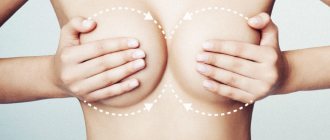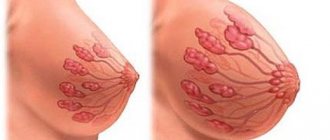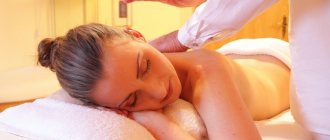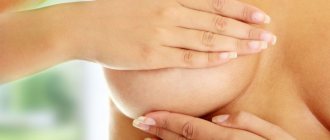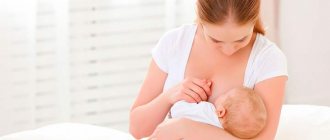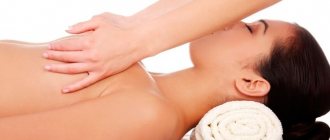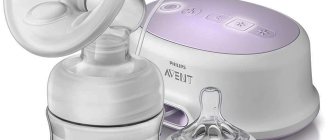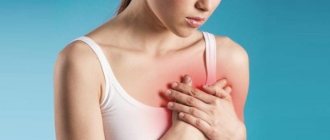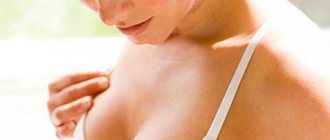Various massage techniques have been used since ancient times to treat and prevent a huge list of diseases. There are both therapeutic and relaxing types of procedures. This amazing treatment came from Asia.
Expectant and nursing mothers do not neglect this technique. After childbirth, you need to massage your breasts during lactation to increase the secretion of the mammary gland, eliminate the risk of stagnation or, conversely, excess milk, as well as rid the body of toxins. This procedure will be useful even if you have no problems feeding your baby.
Preventive massage for nursing mothers will benefit from comprehensive breast care.
Anatomical and physiological features of the mammary gland
Before you begin to study massage techniques, you need to understand how the process of lactation occurs in the body.
The mammary gland is a paired organ. It is present in all mammals and performs the function of feeding. Breasts differ from woman to woman in shape and volume, but this does not in any way affect the quality of lactation. Those. If a woman has curvy figures, this does not mean that more milk secretion will be secreted for feeding than a girl with more modest volumes.
The mammary gland itself is located at the level of the 3rd-7th ribs and connects to the pectoralis major muscle. There is no muscle tissue in the gland itself. Therefore, it is not possible to enlarge your breasts through weight gain combined with exercise.
Milk is produced in a girl's breast during pregnancy. Hormones are responsible for the production of secretions. The lactation process can last from a couple of weeks to several years in each female body individually. The female body is designed in such a way that the more often a child is breastfed, the more milk the mammary gland will produce. Accordingly, when the baby’s sucking reflex disappears (or the mother independently weans him from breastfeeding), the body will limit the production of secretions, and therefore no milk will be supplied to the breast.
Indications for the use of breast massage for lactation
They can be different, ranging from medical to preventive. Among them we can highlight the following:
- pain and discomfort;
- development of mastitis;
- milk shortage problem;
- excess milk production;
- preventing breast stretch marks;
- appearance of cracks.
And this is only part of the list of indications. I would like to emphasize that massage during breastfeeding cannot prevent the occurrence of breast problems during breastfeeding or during pregnancy. However, massage can prevent a number of unpleasant complications.
Lactostasis
Simply put, stagnation of milk in the mammary gland. This disease usually affects primiparous women. The reasons may be either excessive milk secretion or a malfunction in the baby’s feeding regimen.

Doctors at the maternity hospital tell girls about carrying out preventive breast massage to avoid this disease. This procedure can be carried out independently at home.
Doctors recommend breastfeeding your baby more often, expressing milk, and supplementing this treatment regimen with massage to achieve the fastest positive effect.
Hypogalactia
A woman's lack of milk is the case when the movement of the inflow is limited. This complication occurs during the postpartum period. The disease requires treatment, because Due to the lack of milk for feeding, the baby will not receive the required amount of nutrients, which will negatively affect his health. In this case, treatment will be prescribed only after the cause of the disease has been established. But almost all methods include breast massage manipulation.
Stretch marks and cracks
Such injuries on the breast can appear due to the fact that the baby does not suckle properly, and injuries can also occur due to a lack of vitamins in the body of a young mother.

It is impossible to eliminate them with massage, but you can prevent the risk of their occurrence.
Types of massage
Among the many options for breast massage, there are four main techniques:
- General. Its second name is light. Doctors recommend it if there is a lack of milk in the first weeks of feeding, as well as for the prevention of lactostasis.
- Medicinal. It is prescribed and performed by specialists when it is not possible to avoid stagnation of milk in the breast. Compared to the classic one, it is more intense, because its function is to break up clogged blood vessels.
- Lymphatic drainage. Experts do not recommend it to nursing mothers because the procedure removes cell waste products and toxins that enter the bloodstream - and as a result, breast milk.
- Unconventionally dotted. Originally from Eastern countries. It is based on knowledge of certain areas of the human body. Point touches to the area where nerve endings are concentrated improve the process of milk secretion and discharge. To implement the procedure, the presence of a specialist massage therapist is mandatory.
Preparing for a massage
Massage activities are carried out approximately half an hour before the baby starts feeding. Before starting the massage, pay close attention to breast and hand hygiene to avoid the risk of infection. It is also necessary to express milk before the procedure. This can be done either by hand or using a special device - a breast pump.
Having chosen and studied the massage technique for your specific case, you can begin the procedure with clean hands.
Massage technique
To begin, lubricate your skin with a few drops of oil. Oils must be natural and non-perfumed (sea buckthorn, olive, etc.); cosmetics made with goat milk are also suitable. After this, having taken a comfortable position, place one hand under the chest, as if supporting it, and perform impacts with the other. You need to allocate about ten minutes for the session, i.e. five minutes on each breast. After the procedure you need to take a warm shower.
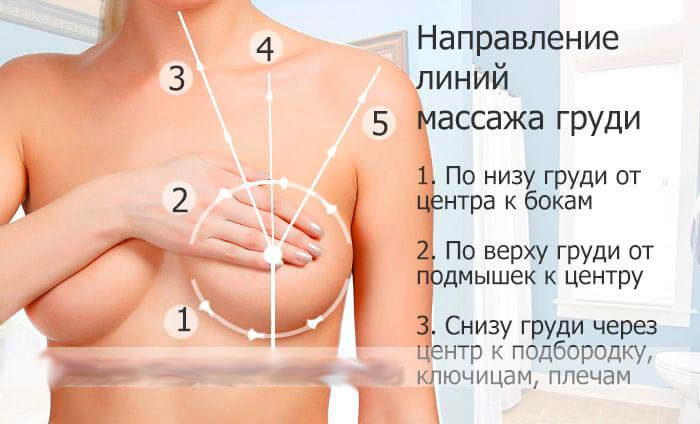
Mastering the massage technique itself during the lactation period is not at all difficult. Even a busy young mother who devotes all her free time to her newborn baby can find a few minutes a day to treat herself to a relaxing massage procedure. Thanks to it, you can minimize the number of problems that arise during lactation.
Please note that manipulations are carried out not only for direct feeding of the baby. Breast massage for pumping is also important.
Stages of breast massage to improve lactation
Massage is one of the most accessible and gentle ways to have a positive impact on health. With such an ailment as a lack of milk secretion, a therapeutic massage is necessary. The technique is quite simple and can be used either by a doctor in a clinic or at home independently. Let's give an example of how to massage the breasts during feeding in several stages.
Massaging
Wash your hands and chest well in warm water. Lubricate your breasts with natural oil, avoiding the nipple area.
Using the palm of your hand, without intense or sharp pressure, rub it several times across the chest in the direction from the base of the mammary glands to the nipple. In the direction of the spiral, move your palm from the collarbone to the nipple. Here stronger palm pressure is allowed. If you feel pain, then try to reduce the intensity of the pressure, increasing it gradually.
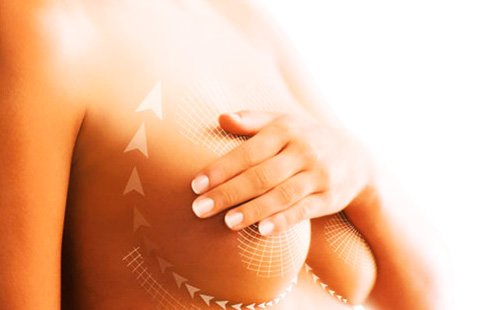
Decantation
Next you need to move on to the nipple itself. It needs to be massaged and kneaded. This must be done without excessive squeezing, using gentle massaging movements.
The next step is the straining procedure. Stroke the breast from its base in a straight line to the nipple, increasing the pressure. This must be done starting from different points of the chest, in a circle.
Kneading seals
If there are lumps on your chest, pay special attention to them. They need to be kneaded more thoroughly. You should not feel pain during the massage, since lumps are stagnation that are not part of the body, and therefore cannot hurt on their own. Combine massage of the breast itself and kneading the seals in it. When acting on the seal, it is necessary to increase the pressure slightly.
After the massage
Upon completion of the manipulations, you need to take a warm shower and relax. In the shower you can also perform a final hydromassage using a shower head. Make circular movements with your fingers in a spiral direction from the base of the breast to the nipple.
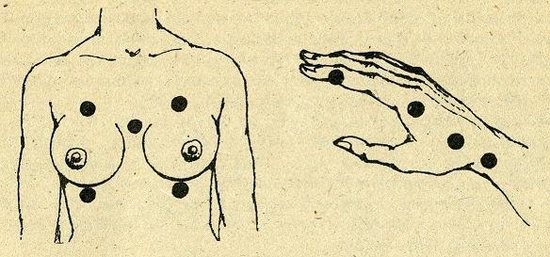
After completing the massage activities, you should start feeding the baby, and then express the remaining milk. Clogged passages will be cleared and inflammation will decrease.
In what situations is massage needed?
Even if lactation is going well, the woman has enough milk, and she does not feel discomfort either before or after feeding, massage will be beneficial for the glands. Although it is not required. Consultants recommend massage in the following cases:
- When expressing milk. If a mother is forced to stop breastfeeding (for example, if she takes medications that are incompatible with breastfeeding), she expresses milk to maintain lactation and prevent stagnation. Massaging will help stimulate the production of oxytocin and sufficient nutrition for the baby.
- To enhance lactation. Massage increases blood circulation and activates the glands, therefore milk production accelerates.
- To increase tissue tone. During breastfeeding, the shape of the breast changes in almost all women. To avoid deformation of ligaments and muscles, toning techniques are performed.
- With stagnation of milk. With this problem, it is recommended to put the baby to the breast as often as possible, gently massaging the lumps.
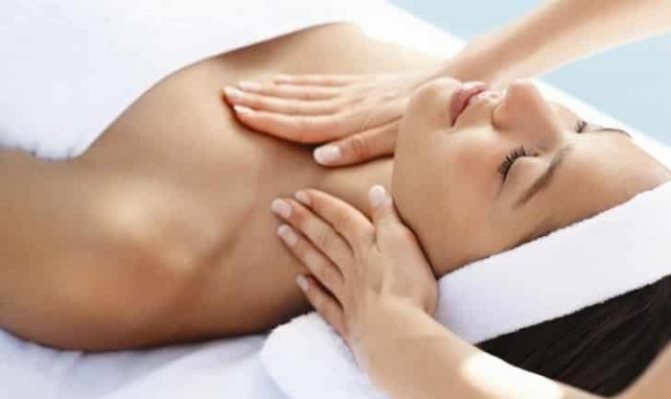
Preventative techniques relax the muscles and ducts, maintaining milk production levels. They will help maintain breast elasticity after breastfeeding and prevent stretch marks, cracks and mastitis.
For milk to come in
After childbirth, there is no need to do a special massage. The breasts are very sensitive and vulnerable during this period. It is important to put the baby to the breast in the delivery room, and then to put the newborn to the breast as often as possible. This stimulation will be quite enough for milk to come in. In the first days, the baby is well fed with colostrum; transitional milk will appear on days 3-7.
Before feeding to enhance lactation
Breast massage for milk will be useful if lactation is not very active and the milk released is not nutritious enough for the baby. This can be judged by weight gain. Additionally, the consultant may recommend vitamins or dietary adjustments.
Before breast massage to increase lactation, you need a little preparation:
- rinse your nipples and breasts, wash your hands with soap without aromatic additives;
- hands should be warm;
- lubricate the chest and palms with a small amount of oil, avoiding the nipple and areola area;
- put one hand under the chest, holding it, the second on top - it will be working;
- After the massage, rinse your breasts with warm water in the shower, moving in a circular motion from the base to the nipples.
The movements that need to be performed with the working hand depend on the massage technique. Among the oils, you can choose special massage oils without vents or vegetable oils: olive, sea buckthorn, jojoba, peach.
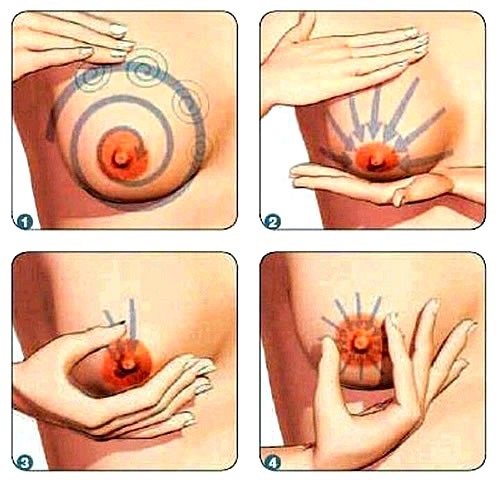
It is important that they do not cause individual intolerance and do not get on the nipples and areolas! To check tolerance, place a drop of oil on the crook of your elbow and monitor the condition of the skin for several hours.
The most comfortable position for massaging before feeding is sitting or reclining with a pillow or cushion under your back.
How to properly massage and knead your breasts to improve lactation:
- starting from the top, pressing the base of the chest with your palm, move the fingers of your working hand in a circular motion in one place for several seconds;
- move your fingers to another area of the chest - in a spiral towards the areola;
- stroke with light movements from the top of the chest to the nipples to stimulate muscle tissue;
- gently shake your breasts by leaning forward, holding them - this will cause a rush of milk closer to the nipples under the influence of gravity;
- fingering, move, tapping, from the periphery to the nipples.
After the procedure, rinse your chest with warm water under a diffuse stream in the shower.
For lactostasis
Massage during milk stagnation will help normalize the passage through the milk ducts, stimulate the glands and avoid hardening of the soft tissues. Lactostasis during feeding is indicated by symptoms such as pain in the chest and armpits, pain when touched, and a decrease in milk volume.
First aid is a child. Applications on demand help relieve congestion. Massage is only an aid.
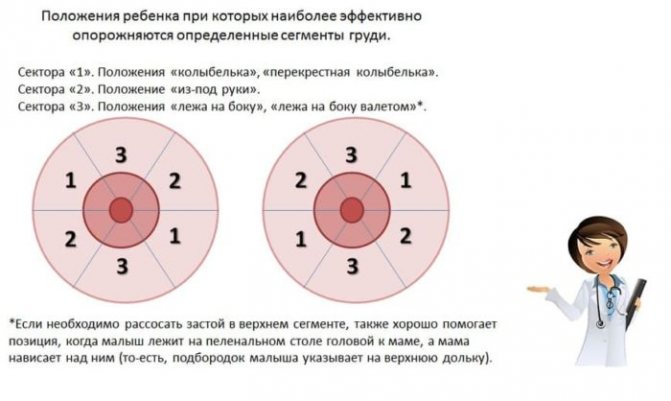
Breast massage during breastfeeding to treat lactostasis:
- stroke your breasts from the base to the nipples;
- stroke with your entire palm in a spiral in the same direction, slightly increasing the pressure;
- massage the nipple, gently twisting it;
- stroke your palm from above to the areolas, increasing the pressure;
- gently knead the inflamed areas, avoiding sharp pain;
- stroke again from top to bottom and take a warm shower.
The procedure should not take more than 7-8 minutes. Immediately before feeding, you can lightly massage the nipple, using only clean hands. Correctly performed technique eliminates congestion, softens tissue and reduces pain.
After completion of breastfeeding for chest pain
Soreness after the end of lactation indicates that the mammary glands are inflamed or the hormonal levels have not yet recovered - oxytocin continues to flow, stimulating the functioning of the organ. Before practicing self-massage, you should consult your doctor.
The result of regular fluid stagnation or anatomical features of the glands can become cysts in the ducts. Only a mammologist can diagnose them. If you have cysts, self-massage is prohibited!
If the pain is caused not by cystic formations, but by swelling, the traditional massage technique given below is indicated.

Massage for lactostasis
Breast massage to increase lactation, like any other manipulation on the body, requires careful preparation and adherence to certain recommendations. Every nursing mother should get to know them.
Some doctors claim that with the help of massage it is impossible to increase the amount of milk produced by the body. This is true, massage does not help increase secretion production, but with the help of such manipulations it will be possible to get rid of congestion that can interfere with normal feeding. Perhaps milk simply does not come out of the gland in the required quantity. In such cases, massage will be effective.
Peculiarities
Obligatory hygiene when performing a massage. For nursing mothers, it is extremely important to maintain cleanliness. Otherwise, you can get an infection both yourself and harm the child’s health. Wash your hands with soap before handling. But it is recommended to simply rinse your breasts with warm water, because... Soap can cause the skin to become very dry, resulting in cracks.
The duration of manipulations should not last more than five minutes.
Breast massage to improve lactation should be done daily - no need to overdo it. There is no point in creating unnecessary impact on the mammary gland.

Pay attention to how you feel during the procedure. A massage should not cause pain, but rather bring pleasant sensations that help you relax. If you feel pain, first try reducing the intensity of the pressure; if this does not help, then stop the massage and consult your doctor.
When is the best time to have a massage?
In addition to its healing properties, the procedure is relaxing, so the massage should only be performed in a calm environment. Before manipulation, create conditions around yourself in which you will feel as comfortable as possible, without being distracted by external stimuli. It will be quite easy to do this - it takes very little time to massage, but the benefits will be enormous.
It is important to massage the breasts before feeding the baby, because... The final stage of the procedure involves the newborn. Thanks to the movements with which the baby sucks the breast, the remaining congestion can be softened and completely eliminated.
Preventive massage
Based on the name, it is easy to understand that the massage procedure for the female breast in this case is prescribed to prevent diseases associated with stagnation of milk, or its lack in the first postpartum days.
Important! Preventive massage is done slowly and smoothly.
A general diagram of how to do breast massage is presented here:
- One palm rests just below the collarbone, supporting the chest. The second - working - rests on top.
- Using smooth strokes in a circle, move from the base of the bust to the nipple.
- Then move on to the décolleté area – slowly and gently stroke the breasts from top to bottom.
- Lean forward and shake your breasts slightly - milk outflow will be activated.
- Also gently knead and slightly pull the nipples - this will avoid unwanted cracks.
- Finish the session with hydromassage - take a warm shower.
It is believed that proper breast massage is an effective aid in improving milk flow. And it is preferable to other options (for example, tea to enhance lactation) because at the time of massage, metabolic processes in the mammary glands are accelerated, which significantly improves milk flow.
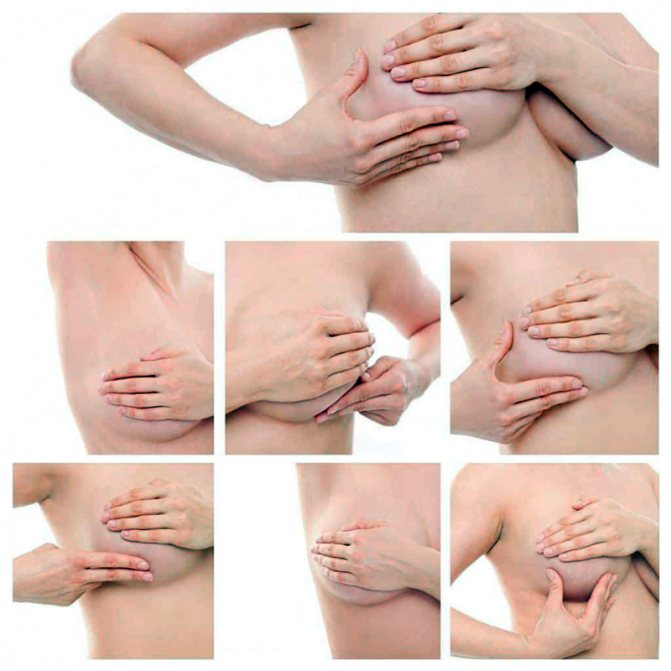
Doctors recommend starting preventive massage on the second day after birth. And first you should massage the upper back and neck. The procedure is performed while sitting, so you should ask your family for help.
Contraindications
Despite all the benefits of massage, which is performed after childbirth for a nursing mother, this procedure has some contraindications. You need to pay attention to them to avoid harm to your health.
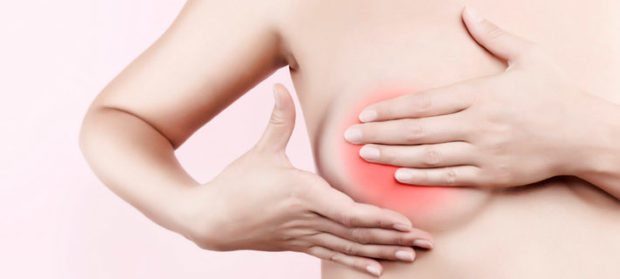
The list is as follows:
- Diseases of a chronic and infectious nature.
- Benign and malignant neoplasms.
- Skin diseases, wounds and cuts.
It is necessary to consult a doctor; the effectiveness and possibility of carrying out massage activities will depend only on his decision. The doctor also needs to know about all the symptoms that bother you while breastfeeding.
It is not recommended to do massage for these pathologies. Exposure to areas affected by tumors can provoke their growth and lead to disastrous consequences. When pressing on the damaged epidermis, there is a risk of infection, which is strictly contraindicated for a young mother and child.
Please note that the main reason for performing breast massage during lactation should be a consultation with your doctor.

You should not make decisions about treatment options on your own. There are a great variety of massage techniques, and depending on your specific problem, the doctor will select the most effective one for you. Be sure to inform him about the presence of any pathologies or chronic diseases.
Benefits of massage
Breast massage during breastfeeding will only become useful if the nursing mother follows all the recommendations and performs the technique correctly. A positive result can only be achieved through regular procedures. By devoting 5-10 minutes a day to her health, a woman takes care not only of herself, but also of her baby.
Mother's milk is a natural product that a newborn simply needs in the first stages of growth. It is imperative to monitor the condition of the mammary glands in order to promptly detect reasons that may become an obstacle to the natural feeding of the baby.
Results
In order to maintain normal health, and feeding becomes comfortable not only for the child, but also for the mother, you must adhere to the following rules:
- Forget about a hot shower and especially a bath. Avoid overheating the mammary glands.
- You cannot limit your drinking regime.
- Be sure to have a balanced diet rich in vitamins B (iron) and C.
- Under no circumstances should you stop breastfeeding, even if symptoms of milk stagnation appear.
- A daily massage of the shoulder and chest glands will relax the muscles that are tense during the day.
And, of course, go to the hospital in a timely manner for examination, even if the cause for concern seems minimal. Obstetricians and gynecologists will definitely tell and show how to properly massage breasts for nursing mothers.
